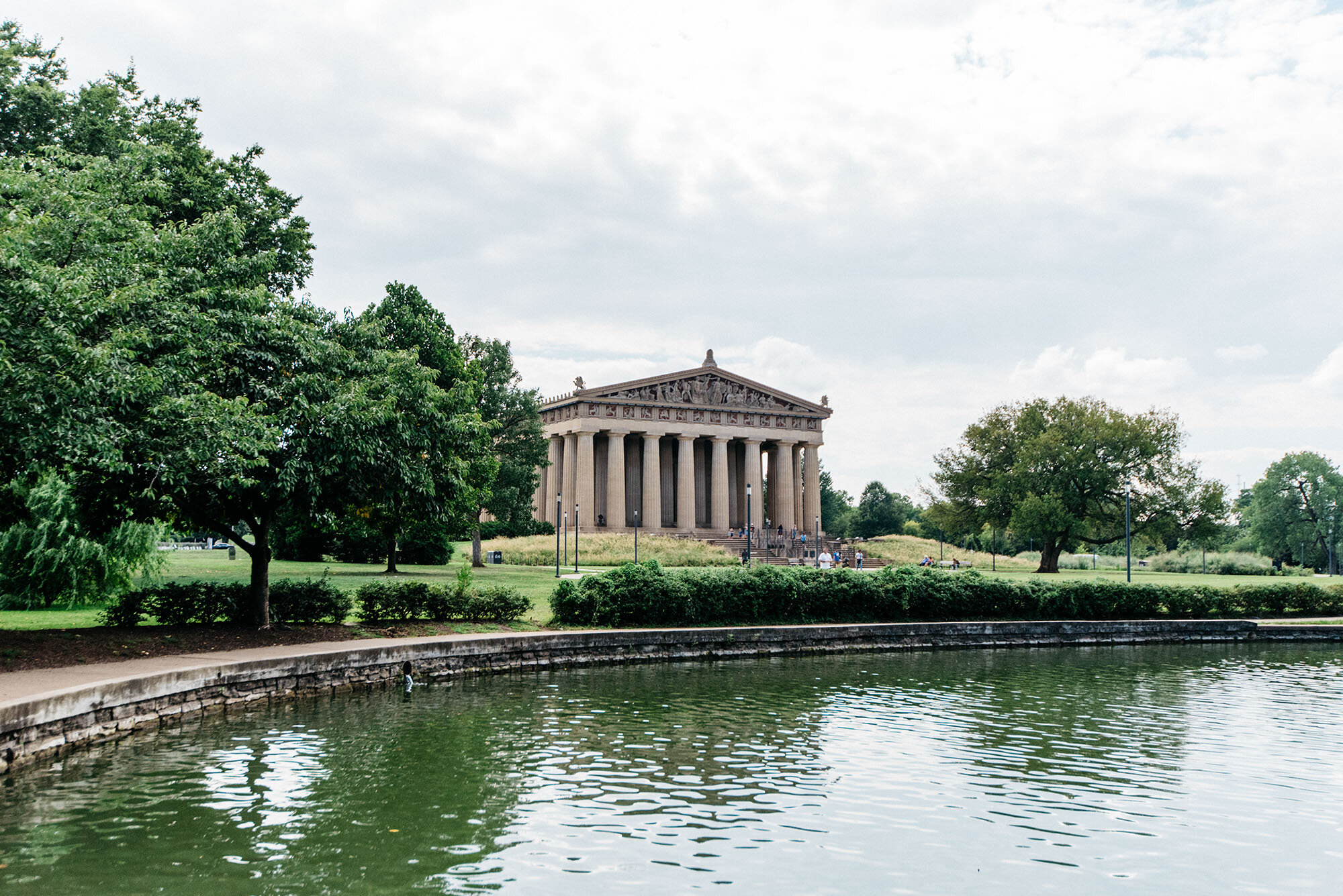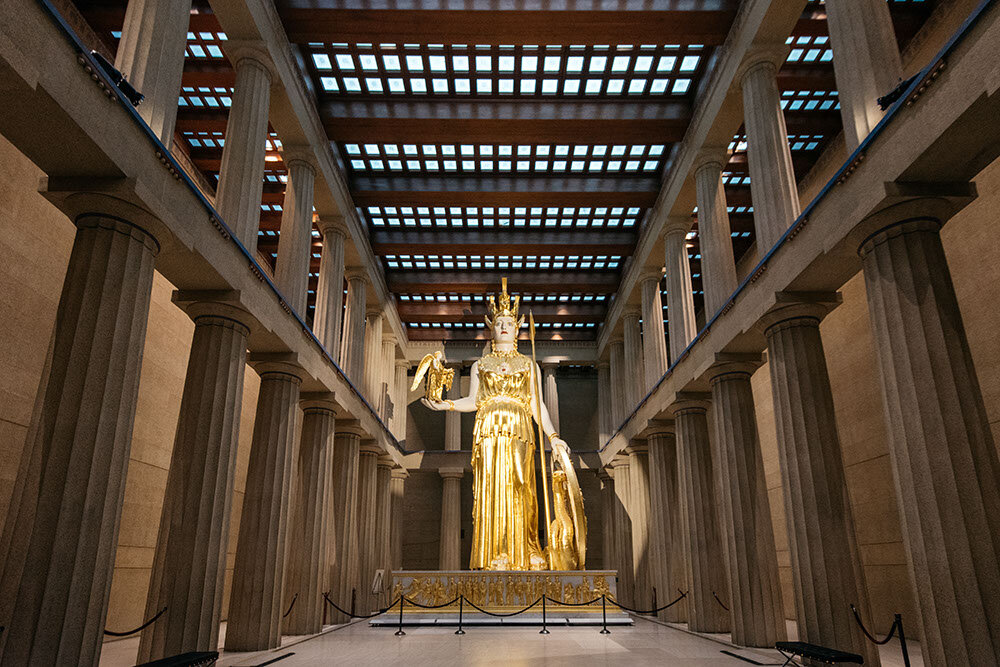About the Parthenon
Mission
Since the 1930s, the Parthenon has continued to host changing art exhibitions in its galleries and to educate both Nashvillians and visitors about the legacy of the ancient Greeks and their impact on American civilization. The Nashville Parthenon is owned and operated by the Metropolitan Board of Parks and Recreation, a Department of the Metropolitan Government of Nashville and Davidson County.
Our mission:
Educate the public concerning the Parthenon and the civilizations which built it, both in Athens in the 5th century BCE and in Nashville, Tennessee, from 1897 to the present.
Exhibit, collect, and care for objects and information related to 5th century BCE Athens, the Tennessee Centennial Exposition, and the rebuilding of the Nashville Parthenon.
Exhibit, collect, and care for visual art and to educate the public concerning its various forms.
Centennial Park Conservancy is the Parthenon's support organization and works to preserve and enhance the Parthenon and Centennial Park while presenting enriching programming to share these two Nashville treasures with our community and visitors.

The Parthenon in Nashville is the world’s only exact-size and detail replica of the original temple in Athens, Greece. When Tennessee celebrated its 100th year of statehood with the Tennessee Centennial Exposition, Nashville took advantage of its nickname “Athens of the South” and built the Fine Art Building as a copy of Athens’ most famous building and the epitome of Greek classical architecture. Although built to be temporary, as were all the buildings of the Centennial, the Parthenon crystallized for Nashvillians their image of themselves and their city and they were loathe to tear it down at the conclusion of the exposition. The exterior coating, sculpture and decorative work were made of plaster and soon deteriorated. Repeated patching kept destruction at bay for several years, but in 1920 the city was forced to a permanent solution: tear it down or rebuild it in lasting materials. The decision to rebuild involved local architect Russell Hart and, as consultant, architectural historian William Bell Dinsmoor.
The roof, expanded walls and load-bearing columns were made of reinforced concrete, the novel new building material of the twentieth century; the brick walls and non load-bearing columns of the 1897 building were retained and incorporated into the new construction. For the permanent surface treatment Hart selected a cast concrete aggregate, using a formula developed by John Earley of Washington, DC. This material was used for all exterior surfaces as well as the roof tiles, decorative work and sculpture. The firm of Foster and Creighton were the general contractors for the rebuilding. Sculptor George Julian Zolnay, who had created the pedimental sculptures on the 1897 Parthenon, returned to make the metopes of the Doric frieze. Nashville sculptor Belle Kinney and her Austrian-born husband Leopold Scholz were hired to create the permanent pediment figures. To assist them in creating figures as close to the original as possible, the Park Board purchased from the Victoria and Albert Museum a set of casts of the original marble fragments. Work on the exterior of the building was completed by 1925.
The Parthenon built for the Centennial was not a replica on the inside; its interior was a series of galleries for exhibiting the enormous collection of paintings and sculptures borrowed from Europe and throughout the United States for the Exposition. The permanent structure, however, was to be a compete replica and as accurate as scholarship would allow, recreating the camber of the horizontal lines, the inclination of columns and walls and the entasis of the columns. Due to various financial crises, work continued haltingly until its completion in 1931. When the doors were opened to the public, two major elements were still missing: the great statue of Athena in the naos and the Ionic frieze on the exterior. Donations for the Athena accumulated over the years and in 1982 the Park Board commissioned Nashville sculptor Alan LeQuire to recreate the 42ft statue for the interior. This monumental task took almost eight years. The statue was finally unveiled on May 20, 1990, generating much excitement and a renewal of interest in the Nashville Parthenon as an icon of the city. Additional money was raised during the next 12 years, and in 2002 the statue was finally completed with gilding and painting.
History of the Nashville Parthenon
1895 Tennessee Centennial organizers lay the first foundation stone of the Nashville Parthenon. The Parthenon, made of plaster, wood and brick, is the first building to begin construction for the Tennessee Centennial Exposition.
1897 The Tennessee Centennial Exposition is held May 1 - October 30, 1897. Like a world's fair, all the exhibit buildings are temporary and made of inexpensive materials. Over the six month duration, approximately 1.8 million people attend the Centennial.
1898 The majority of the Centennial buildings are moved or destroyed. The Parthenon remains the centerpiece of the empty fair grounds.
1901 The Nashville Board of Parks is created.
1902 Centennial Park is established out of much of the Tennessee Centennial grounds. The Parthenon stands at the center of the new municipal park.
1915 The temporary nature of the plaster Centennial Parthenon is obvious. The pediment sculptures are removed for safety reasons.
1920 The city of Nashville decides to make the Parthenon a permanent aggregate concrete structure. Local architect Russell Hart is hired for the reconstruction.
1925 The exterior of the newly reconstructed Parthenon is complete.
1927 From 1927 - 1929, James Cowan donates 63 paintings to the city of Nashville with the understanding that they will hang in the newly renovated Parthenon.
1931 The interior of the replica is complete. The Parthenon re-opens to the public as a city museum on May 20, 1931.
1954 - 1967 The Harvey's Nativity Scene is displayed in front of the Parthenon every Christmas.
1982 Alan LeQuire is commissioned to re-create Athena Parthenos in Nashville.
1987 - 1988 Interior renovation of the lower level is completed, providing improved galleries, art storage, exhibit prep areas, a new gift shop, and expanded restroom facilities.
1990 The Nashville Athena Parthenos is unveiled to the public on May 20, 1990.
1991 A fence surrounds the Parthenon as restoration begins.
2001 The restoration of Nashville's Parthenon is complete and the official unveiling celebration is held on December 31, 2001.
2002 June 3 - the Athena statue is placed back in scaffolding as the gilding process begins. The statue is being gilded in gold to more closely resemble the original Athena Parthenos
The Architecture of the Parthenon
The Parthenon in Athens was carved out of Pentelic marble and it took the Athenians approximately 10 years to construct the building, 447-438 BCE. Architectural sculpture work continued into approximately 432 BCE.
All horizontal architectural elements arch slightly in the center. This means there are no true straight horizontal lines in the Parthenon. These architectural refinements made the Parthenon look alive and flawless to the human eye. This curvature is repeated in the Nashville Parthenon.
The Nashville Parthenon was created from brick, stone, structural reinforced concrete, and cast concrete aggregate. It took the City of Nashville nearly 10 years to build their Parthenon, 1921-1931.
The Parthenon is 65 feet high at its apex.
The peristyle consists of 46 Doric columns—17 on each side, six on each end (not counting the corner columns twice).
All the exterior columns incline slightly inward. The corner columns are diagonally inclined; that is, they are angled toward both sides. Scholars disagree on the precise reasons for these refinements, but they clearly serve the aesthetic functions of the building.
The columns of the building differ in diameter from the ones beside them and are all spaced slightly differently.
All the columns share a refinement called the entasis, a slight bulge or convex curvature of the column shaft. Although the shaft tapers, the largest diameter is about one-third of the way up the column, rather than at the base.
The interior of the Parthenon is divided into two rooms. The east room is called the Naos and it houses the statue of Athena. The Naos is 93 feet long and 63 feet wide and has a two-story colonnade around three sides. The west room is 44 feet long by 63 feet wide and is called the Treasury. In the Classical period, this room housed the treasure of the Delian League, a prominent alliance of city-states with Athens at its helm.






